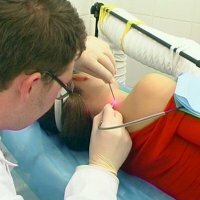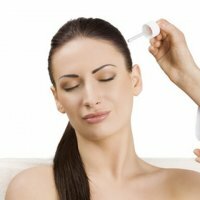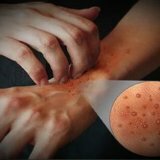Rosacea: Symptoms, Causes, Modern Treatments
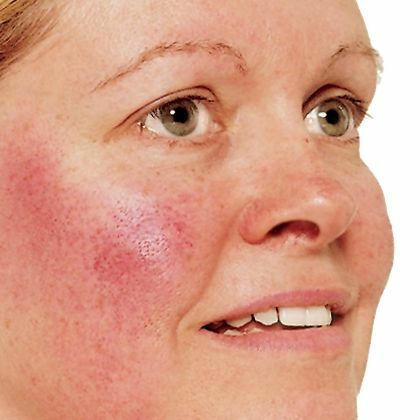
Rosacea is a chronic skin disease caused by the damage to the blood vessels of the face, which is manifested by thickening of the skin, pustular eruptions and difficulty in exfoliating the epithelium.It is characterized by a chronic course with periods of exacerbation.The danger of this disease lies in the fact that with prolonged flow and lack of treatment, rosacea on the face can lead to tangible cosmetic defects.
Contents: Causes of rosacea and risk factors How does rosacea manifest itself Rosacea complications Rosacea treatment Rosacea preventionCauses of rosacea and risk factors
So far, scientists can not name the exact cause of this skin disease.It used to be that the main cause of rosacea was demodicosis , but it was found that these are two different diseases, although they mutually aggravate each other.Currently, experts attribute rosacea to multifactorial diseases, arising from a combination of several reasons.
The causes of rosacea in this video review are described by a dermatologist:
The following factors can be distinguished, in which case the chance of this pathology is significantly increased:
- Hair color: blond and red people have more sensitive skin.What classifies them as a risk group.
- Menopause in women.Although mostly men and women suffer from rosacea with the same frequency, during the menopause in women the probability of getting sick is somewhat higher.It is caused by hormonal reorganization of the organism, in which the fragility of the vessels increases.
- Diseases of the digestive tract.In patients with gastritis and duodenitis( inflammation of the duodenum), rosacea is more common.Especially clear is the relationship, if confirmed the fact of colonization of the stomach by the bacterium Helicobacter pylori.
- Use of hormonal ointments.Frequent application of glucocorticosteroid ointments on the skin leads to thinning of the vessels, strengthening their fragility, which can provoke the disease.
- Dermatitis.Contact and allergic dermatitis also causes a change in the properties of the skin vessels, which leads to an increased risk of rosacea.
- Endocrine diseases.
- Vascular dystonia in cardiovascular type.
- Features of the climate.Living in an area where the skin is often exposed to dry or cold air( the Far North, steppe regions).
- Genetic predisposition.Among the peoples living in the north, rosacea occurs 1.5 times more often.
The debut of rosacea can provoke any negative factor:
- Stress;
- supercooling;
- contact with hot or, conversely, very cold water;
- Alcohol consumption;
- sudden change in air temperature.
Rosacea may occur in a pregnant woman.At the same time the disease is lightning fast, but disappears after birth.The risk of relapse rises with each new pregnancy.
How rosacea is manifested
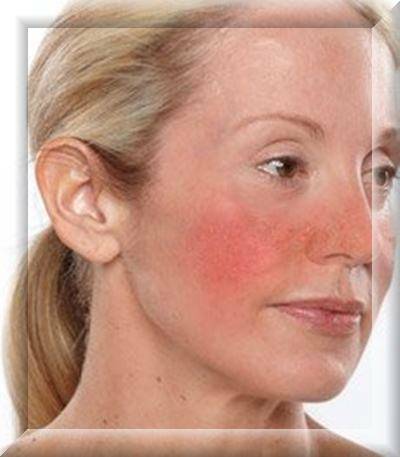 The first symptom of rosacea is the precipitation of red spots on the face immediately or a few minutes after the action of the provoking agent.The spots are mainly localized on the forehead, cheeks, nose and chin.It is very difficult to suspect rosacea at the initial stage, since rashes, except that they do not disappear for a long time, do not give a person any discomfort.These spots are easily concealed by ordinary cosmetics.
The first symptom of rosacea is the precipitation of red spots on the face immediately or a few minutes after the action of the provoking agent.The spots are mainly localized on the forehead, cheeks, nose and chin.It is very difficult to suspect rosacea at the initial stage, since rashes, except that they do not disappear for a long time, do not give a person any discomfort.These spots are easily concealed by ordinary cosmetics.
Reddening attacks are becoming more frequent and provoked in the future all the easier.The constant expansion of the vessels is accompanied by a feeling of heat on the face.The increased blood supply to the skin of the face results in the activation of microorganisms permanently on it.This leads to the formation of tubercles on the skin.If there is no treatment at this stage, small abscesses may appear.
Rosacea stages
| Prerozatsea | Vascular rosacea | Inflammatory rosacea | Later rosacea | |
| Transient erythema and hyperemia | edema, oftalmorozatsea | Persistent erythema and television angiectasia | papules andPustules | Rhinophyma |
At a later stage, rosacea of the skin leads to a change in the structure of the skin on the face: they become rough, dense to the touch.Chronic expansion of the hypodermic capillaries becomes noticeable with the naked eye - a vascular reticulum appears on the face.Individual vessels with rosacea expand especially strongly - telangiectasia appears.At this stage of the disease, reddening of the skin is permanent and is no longer associated with provoking factors.
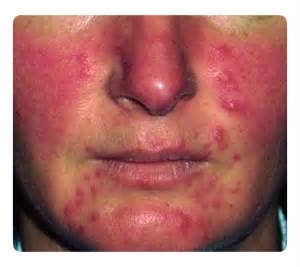
The last stage of rosacea is lupoid, manifested by numerous rashes around the orbit and mouth in the form of brownish-red nodules and spots.With a particularly unfavorable course, the tendency of these rashes to merge is noted.The stage is named so because of the similarity of the clinical picture with the manifestations of systemic lupus erythematosus( from Latin - lupus).
Common symptoms of rosacea are:
- skin itching in the area of rashes;
- burning;
- sensation of constricting skin;
- paresthesia in the form of "goose bumps" on the skin.
A typical symptom of rosacea in men is a more pronounced thickening of the skin of the nose.This leads to the fact that rosacea is complicated by a rhinophyma as well.
Rosacea Complications
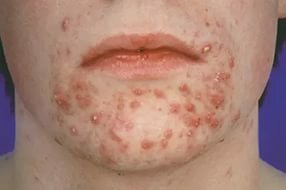 Although rosacea is considered a relatively safe disease, it can be accompanied by rather unpleasant phenomena.Even at the earliest stage of the disease, dry eyes can be noted, manifested by the sensation of rubbing, a feeling of "sand" in the eyes.At a later stage, the symptom of dryness is replaced by a tendency to lachrymation.In this case, they speak of ocular rosacea.
Although rosacea is considered a relatively safe disease, it can be accompanied by rather unpleasant phenomena.Even at the earliest stage of the disease, dry eyes can be noted, manifested by the sensation of rubbing, a feeling of "sand" in the eyes.At a later stage, the symptom of dryness is replaced by a tendency to lachrymation.In this case, they speak of ocular rosacea.
The most formidable complication of rosacea is rosaceaakeratitis - the damage to the cornea of the eye, in which ulcers and seals form on the cornea.If untreated, this condition can lead to blindness.
Treatment of rosacea
In the initial stages, this disease is quite easy to treat, but the neglected cases when telangiectasia or rhinophyma have already appeared, it will take a long time to treat rosacea.
The main cause forcing patients to seek qualified help is pustular rash on the affected area.In this case, the doctor prescribes ointments with antibiotics.If local drugs( gels and ointments) are ineffective, antibiotics are prescribed for systemic administration - in the form of tablets.A good effect shows a cream from rosacea with metronidazole.As an aid, infusions and decoctions of some herbs( chamomile, thyme) are used - they have a weak antiseptic effect.
Treat rosacea at home and with the help of folk methods should only after consulting a doctor, since the risk of complications is high.Non-compliance with medical recommendations can lead to the fact that the small pustules turn into abscesses, which will have to be opened and drained.
The duration of rosacea treatment is often several weeks.The main task in the acute period is to eliminate the inflammatory phenomena, after which it is possible to start treatment of the main cause of the disease - the expanded subcutaneous vessels.
You can remove the dilated vessels with rosacea in two ways: :
- Cryotherapy.Local exposure to low temperatures causes vasospasm, and with repeated exposure, sclerosis( overgrowing) of capillaries is noted.
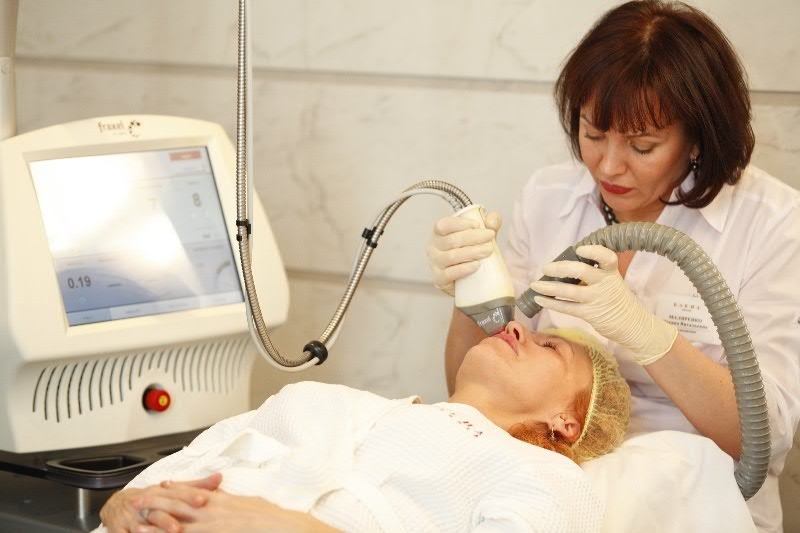
- Laser therapy.Rosacea is treated with a laser in 95% of cases, especially in the initial stages.
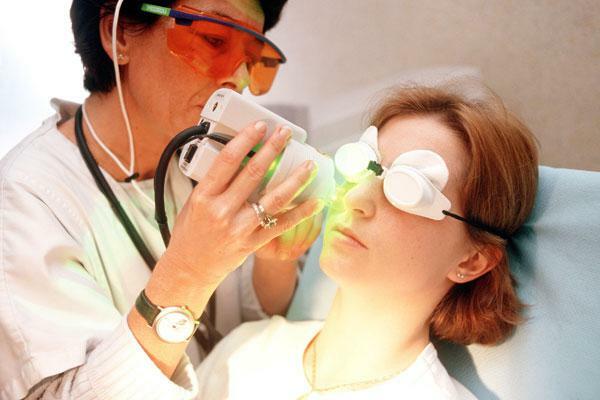
The effect of treatment can be assessed after several procedures.Patients themselves notice that the expression of red spots on the face is significantly reduced, completely disappeared unpleasant sensations - burning and itching.After completing the full course of therapy, it is recommended to use a cream protecting against ultraviolet radiation in the summer.
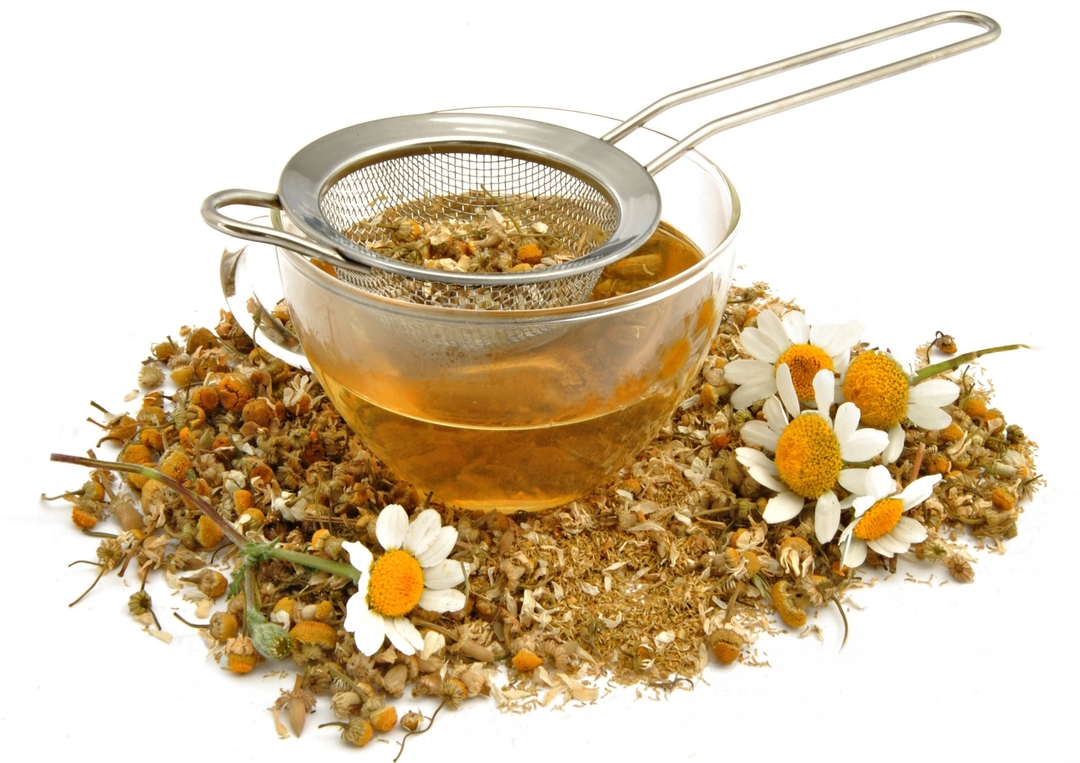
Prevention of rosacea
Neither laser therapy of rosacea, nor cryotherapy does not guarantee that the disease will not worsen.To prevent recurrence, you should regularly undergo preventive treatment with laser or cold.
However, the frequency of visits to a cosmetologist about this disease can be significantly reduced, you just have to adhere to simple rules:
- Do not sunbathe the person, if possible, use a protective cream
- In winter, avoid hypothermia and exposure to cold, dry faceAir( you can use creams with high fat content).
- Balance the diet - it must necessarily contain enough vitamins A, E and be absent - fried peppery, fatty foods
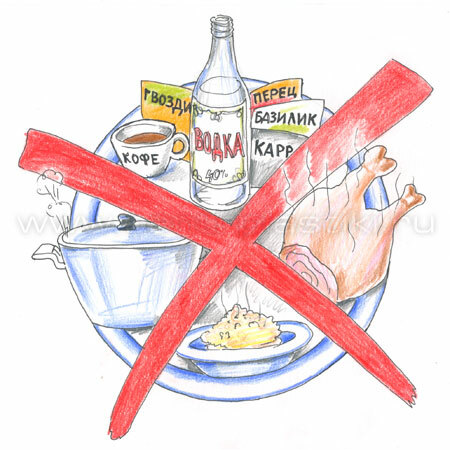
- Treat all diseases of the gastrointestinal tract, especially gastritis and peptic ulcer.
- Refuse to use hormonal ointments( unless they are prescribed for a serious illness).
Roman Gudkov, resuscitation specialist, anesthesiologist

